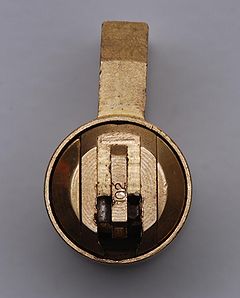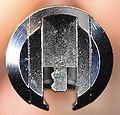BiLock FG: Difference between revisions
mNo edit summary |
m (category:slider locks) |
||
| (5 intermediate revisions by 3 users not shown) | |||
| Line 6: | Line 6: | ||
| maker = [[Australian Lock Company]] | | maker = [[Australian Lock Company]] | ||
| lock_type = [[Cylinder]] | | lock_type = [[Cylinder]] | ||
| lock_design = [[Sidebar]] | | lock_design = [[Slider]], [[Sidebar]] | ||
| years_produced = 1981 - Present | | years_produced = 1981 - Present | ||
| related = [[BiLock NG]]<br>[[BiLock QC]] | | related = [[BiLock NG]]<br>[[BiLock QC]] | ||
| patent = [ | | patent = [https://patents.google.com/patent/US4478061A/ US 4,478,061] | ||
}} | }} | ||
| Line 30: | Line 30: | ||
File:BiLock NG pins.jpg|Pins used in the FG, with false gates and master keyed pin shown. | File:BiLock NG pins.jpg|Pins used in the FG, with false gates and master keyed pin shown. | ||
File:BiLock NG sidebar.jpg|One of the sidebars used in the FG. | File:BiLock NG sidebar.jpg|One of the sidebars used in the FG. | ||
File:Bilock_FG_114-autom8on.jpg|FG core with 114 profile. | |||
File:Bilock_FG_back-autom8on.jpg|Rear view of FG core. | |||
File:Bilock_FG_top-autom8on.jpg|Top view of FG core. | |||
File:Bilock_FG_bottom-autom8on.jpg|Bottom view of FG core. | |||
</gallery></div> | </gallery></div> | ||
| Line 73: | Line 77: | ||
[[Category:Australian Lock Company|BiLock FG]] | [[Category:Australian Lock Company|BiLock FG]] | ||
[[Category:Sidebar locks]] | [[Category:Sidebar locks]] | ||
[[Category:Australian Locks]] | |||
[[Category:Slider_locks]] | |||
[[Category:Lock models]] | |||
Latest revision as of 21:28, 23 January 2023
BiLock FG
| BiLock FG | |
 | |
| Name | BiLock FG |
|---|---|
| Manufacturer | Australian Lock Company |
| Lock Type | Cylinder |
| Lock Design | Slider, Sidebar |
| Year(s) Produced | 1981 - Present |
| Patent | US 4,478,061 |
| Related Locks | |
| BiLock NG BiLock QC | |
The BiLock FG (or BiLock First Generation) is a dual-sidebar lock made by Australian Lock Company. The BiLock FG uses twelve pins arranged in two rows of six. Each row of pins uses a separate sidebar located at 3 and 9 o'clock in the plug. The FG is easily identified by the U-shaped key and keyway.
The BiLock FG has since been superceded by the BiLock NG and is available in the BiLock QC interchangeable core format.
Principles of operation
The BiLock FG uses a total of twelve pins arranged in two rows of six. Each row of pins interacts with a sidebar on each side of the plug. Each pin has a round hole, the true gate, and a false gate located two pin depths away from the true gate. The false gate is the same shape as the true gate, but is too shallow to allow the sidebar to fully retract. To open the lock, all pins are raised and the side bar legs retract into the true gate on each pin. There are 4 depths for pins, which allows 16,777,216 (412) theoretical key differs. Master keying is available by using pins with widened or multiple sidebar holes. Master keyed pins do not use false gates.
There is no MACS for BiLock pins, but two four depths (deepest key cut) cannot be opposite one another because it weakens the key.
Notes
- BiLock keys are cut then folded to create their U-shape.
- Newer BiLock FG cores use features taken from the BiLock NG, particularly the removable profile plate. Newer models also use the same plug as the NG (with milled areas for the moving element) but with these components removed. Modern FG keys also shared the rounded bow style used by the NG.
Disassembly instructions
The BiLock FG is easy to disassemble:
- Remove the cam or C-clip.
- Remove the plug from the cylinder. A plug follower is not needed because there are no driver pins.
- Remove the faceplate from the front of the plug to access the moving element and the pin chamber cover.
Vulnerabilities
The BiLock FG may be vulnerable to one or more of the following:
Notes
- The BiLock FG cannot be bumped because it is does not use driver pins.
- Decoding is possible via shimming of the pin channels as well as a pin & cam decoding tool from Falle Securities.[1]
Gallery
Add to me!
References
- ↑ King, Jon & Datagram. (2011) Beating the BiLock







